Finding and rectifying faults in central heating systems is a daunting task. If you are not familiar with central heating systems the jargon can be difficult and fault finding hard to work through. You can potentially save yourself a considerable amount of money and time waiting for a plumber or central heating repair man if you can do some basic fault finding.
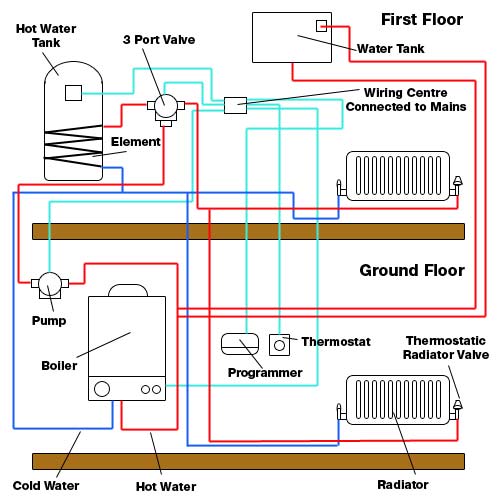
Diagram of typical heating system with boiler, radiators and cylinder
Before you start it is useful to understand the component parts of the system. You will need to know these even if you do need to get an expert in to help you, as they will need to know what is wrong, or at least, what you think is wrong.
If you have a problem with your radiators have at our project on radiator problems.
No matter who you are, an experienced DIY enthusiast, or someone with only a passing knowledge of Central Heating systems, it is well worth trying to diagnose a fault that might occur in your central heating. Even with few tools and limited experience there are a number of common and simple cures and remedies that you can identify and use, or at least rule out before reaching for the phone.
Central Heating Fault Finding Safety Considerations
Before you get started it is really important to have a quick think about yourself and others around you. It is important to make sure that everyone is safe before you start and that you don’t take any unnecessary risks.
Do not go beyond your abilities. Stop when you do not understand what you are looking at or doing; know your limits. There is no shame is calling in a professional.
Here are a number of the things that you should consider when you are fault finding, but please remember this is only a guide and not an exhaustive list:
- Clothing and Equipment: Make sure that you are dressed for the work that you are doing. Tie back long hair, remove jewellery and loose clothing which might get caught. Use protective clothing and other equipment. Dust sheets are very useful, but make sure that they are not a trip hazard
- Water: Central heating water is almost always dirty. Use protective sheets on all capets and vulnerable surfaces which could be stained otherwise
- Ladders and Roof spaces: Have a look at our project on ladder safety is you are unsure about using a ladder. You might find yourself in the roof space; Make sure you have a torch and watch where you tread as no one wants to go through the ceiling. Take care entering through the loft hatch, and don’t leave anything you could slip or tip on there
- Hot water and scalding: You will likely be dealing with hot water or hot pipes so you need to be careful that you are not scalded. It may we worth allowing water to cool before you start work
- Carbon Monoxide: get a carbon monoxide detector and you will be fine
- Electricity and electric shocks: Some components in the central heating system will be supplied with mains electricity. Never work on a live circuit – turn off the supply before your start work. You must be competent and qualified to work with electricity and/or gas or oil heating boilers
- Gas safety: Again you must be a competent person to work with gas. More information on this can be found in our gas safety project. If you smell gas you should do the following:
- Turn off the gas supply immediately
- Extinguish all sources of ignition – don’t use electric lights or any electric switches, such as bell pushes. Don’t smoke!
- Open windows and ventilate the room and building
- Report the gas escape – 0800 111 999
Quick Check List for Fault Finding Central Heating Systems
If you know your central heating system you will have a good idea about its foibles. This should give you a good idea where to start looking if there are problems. If there have been any recently changed parts these should be checked to see that they are not causing problems or possibly the underlying problems has not been resolved.
These are the areas that you will need to check:
- Boiler: Check the pilot light: In older boilers there will be a visible pilot light which will only be alight if there is a supply of gas and electricity. More modern boilers tend to have a pilot flame that is only visible when the boiler fires up, or is not visible at all. Check that there is a gas and electricity supply. Make sure that the flue is not blocked
- Programmer or Clock: Make sure this is switched on and set correctly, with the right date and time. It will need an electricity supply. Check the batteries of a portable or remote (RF – radio frequency) programmer
- Room Thermostat: This needs to be on and requesting heat, or the boiler will not start. The easiest way to check this is to turn it up to the maximum temperature
- Circulating Pump: This needs power from the mains. You should be able to hear the pump or feel its vibration
- Motorised Valves: These require mains power also. Carefully move the manual leaver from "auto" (Automatic) to "man" (Manual) several times and set back to "auto". See if there is any movement when the room or cylinder thermostats call for heat. You should be able to feel the heat from the pipes either side of the valve
- Radiators: Feel the radiator and it is cool at the top, bleed it to vent the air. Take care not to over tighten the valve. Other radiator problems can be solved using our page on radiator problems
- TRV’s (Thermostatic Radiator Valves): Check to see if the pipes either side of the radiator are warm. Turn the TRV to a higher setting and the radiator should warm up. If not you will have to remove the sensor head and check the valve. If the radiator gets too hot or doesn’t respond to the TRV the sensor might be faulty. see our video on TRV’s
- Cylinder Thermostat: If the cylinder is cool or warm, turn up the thermostat and set the Hot Water "on" on the programmer. This should call for heat from the boiler and it should start up. The thermostat should be set to 60°
- Cylinder: If you can feel that there is hot water in the cylinder but it is not flowing or flowing slowly through the tap, this suggests that there is an airlock. If all the hot water taps are affected then it is likely to be an air lock in the cold feed to the cylinder or in the hot water pipes directly from the cylinder
- Water Storage Cisterns (Water Tank): The feed, expansion and cold water storage cisterns should be insulated to stop the water freezing. There should be an isolation valve fitted on the main feed which is operated by a float which will shut off the water when the level rises and lifts the float – check that this is serviceable. For more about water tanks, to understand how the cold water is distributed in your home, see our page on cold water tanks and valves
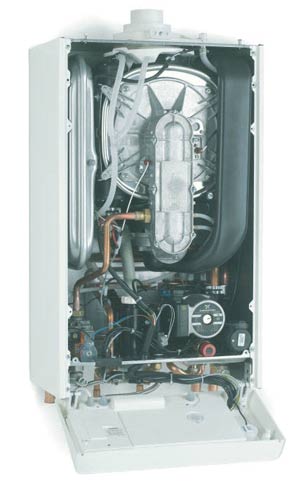
Alpha Intec 34C combi boiler with front panel removed showing internals – Image courtesy of boilers2go.co.uk

Thermostat or programmer for controlling boiler, hot water and heating
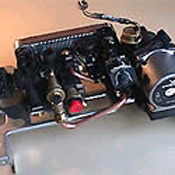
Boiler pump from modern combi boiler
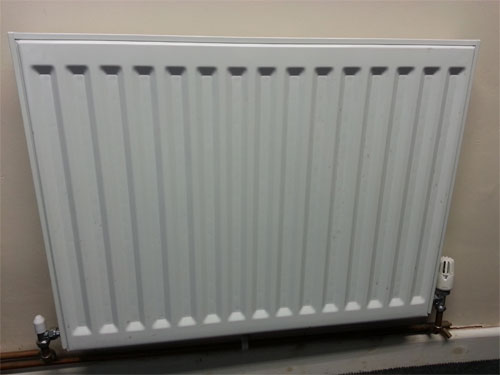
Modern convector radiator

Thermostatic radiator valve
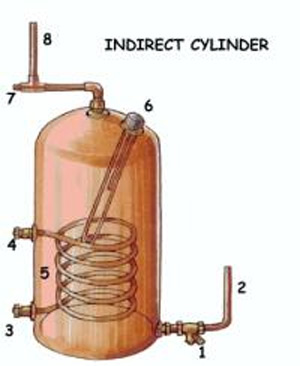
Hot water cylinder cross section of heating element

Float operated isolation valve
Common Central Heating Faults and their Symptoms
These are some of the most commons problems that you are likely to find, their symptoms and an indication of the probably solution.
| Symptom | Fault | Solution |
| No hot water, no heating | Boiler not working | Check gas and electricity mains |
| Faulty programmer | Check programmer | |
| Faulty or seized pump | Repair or replace pump | |
| No hot water but heating is working | Cylinder thermostat has a loose connection | Check and tighten terminal block |
| Broken cylinder thermostat switch | Replace thermostat and test electrical circuits | |
| Faulty programmer | Check programmer | |
| Seized motorised valve | Repair or replace motorised valve | |
| Faulty immersion heater | Check and replace immersion heater | |
| Cylinder hot but no hot water at taps – Airlock | Remove airlock | |
| Cylinder hot but no hot waterat taps – Cold water storage empty | Establish cause of no supply – Unfreeze pipes and insulate |
Professional Tradesmen such as Heating Engineers, Plumbers, Gas Installers (Boilers), when called to a breakdown will fault find in a logical and sequential fashion. They will consider the differential possible causes of the fault and set about the repairing the fault in a step by step manner. They will plan for the worst and by doing so it rarely happens. If it does, at least you are prepared.
Fault Finding when No Heating is Available
The below flow chart has been adapted from Central Heating – Fault Finding and Repair by John Reginald.
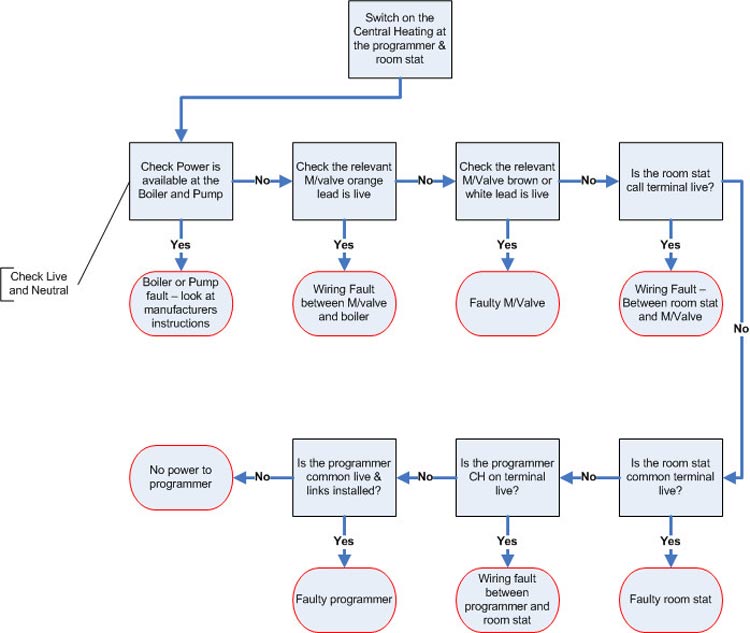
Fault Finding when No Hot Water is Available
The flow chart below has been adapted from Central Heating – Fault Finding and Repair by John Reginald.
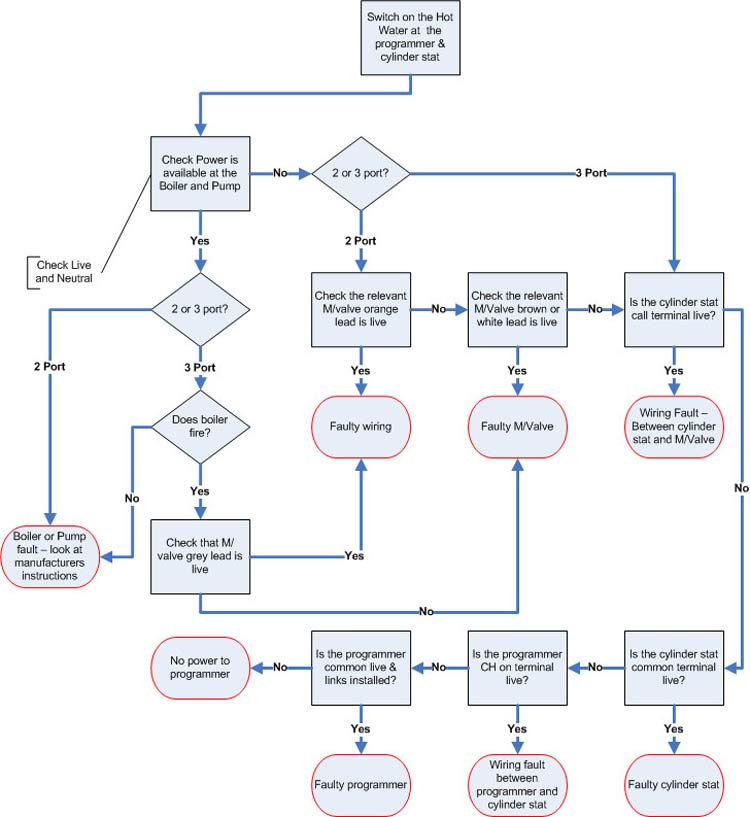
Central Heating – Fault Finding and Repair
We have now sourced what we consider to be a very valuable asset indeed. This book (and its partner Combination Boilers, fault finding and repairs) will be one of the most valuable tools in your bag.
With over 200 pages and 100 illustrations this superb manual will help you understand Central Heating and Hot Water Systems, quickly trace faults, effect professional repairs, reduce wear and tear and eliminate breakdown.
You will be able to effect professional solutions to professional standards on simple and more complex faults. This manual will pay for itself many times over.
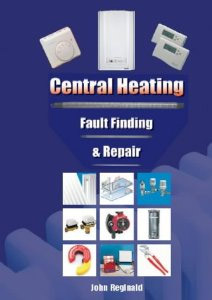
Central Heating – Fault Finding and Repair book
You may also find our Combination Boilers project useful.

